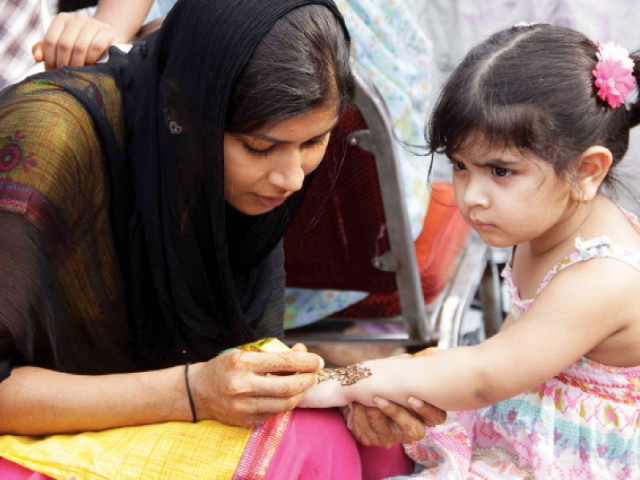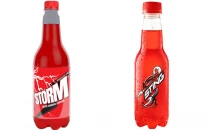Colour me red: Instant mehndi solutions may leave lasting marks
Doctors say ‘emergency cones’ have acid that could leave scars.

Colour me red: Instant mehndi solutions may leave lasting marks
Mehndi – wrapped in shiny green, silver and golden paper cones adorning little stalls in markets across the city – remains the most essential ingredient of traditional Eid celebrations.
While there is great demand for instant colour and darker shades of mehndi, a lot of these ‘emergency mehndi cones’, doctors warn, might just burn one’s festive mood – literally.
As Eid preparations reach full swing towards the end of Ramazan, the demand for mehndi rises as does the number of hawkers one sees selling various kinds of mehndi.
Depending on the quantity and colour, mehndi cones are usually priced between Rs40 and Rs150. But some brands of mehndi are priced higher than others as they promise instant results.
Popularly known as ‘emergency cones’, these ready-to-use mehndi cones offer varied shades including the highly sought after ‘black cone’.
Shahid Aslam, who runs a small setup in Lohari Gate, says black mehndi is most sought during Eid. Aslam says he sells mehndi at the Eid Bazaar in and around Liberty Market each year while his brother sells bangles at the stall next to his.
“My mehndi’s colour is guaranteed... it will be the darkest you’d have ever seen,” he says about the brand of mehndi cones displayed in a conical swirl at his stall. But while he can guarantee colour, Aslam says he doesn’t know what ingredients were used to make the concoction that he sells.
“We buy it in bulk directly from the manufacturers. We don’t ask what is put in it, only whether it leaves a dark colour,” he says.
Like Aslam, several other shopkeepers at the Eid Bazaar in Liberty Market said that they were sure that “some chemical” was used to enhance the mehndi’s colour, though none of them knew what exactly the chemical was. “It doesn’t hurt or burn,” said another shopkeeper selling this type of mehndi at his stall. Cosmetic Dermatologist Dr Zarqa Suhrawardy Taimur, however, says it [the mehndi] does burn. “Maybe not immediately, but it does, soon after it is applied.”
Dr Taimur, who runs her clinic in Gulberg, said she had treated several girls who had complained of skin burns after using chemical-laced mehndi. “Many girls suffer serious skin burns that often leave permanent marks on the skin.”
Dr Taimur said several mehndi manufacturers use acids of varying strengths in the mehndi. That is what causes skin to burn. “So girls’ desire to have dark and long-lasting mehndi colour leaves them with permanent marks in the form of burns,” she said.
Salma Rasheed, a small-scale beautician offering mehndi application services at home, says though she has never met anyone who suffered from burns caused by using ‘emergency cones’, she says that she believes in traditional tips to get that dark rich henna colour. “I sell these widely available mehndi cone brands to my clients but they do not have that pure henna fragrance…at times they smell strongly of chemicals,” she said.
Rasheed’s home remedy for achieving a dark henna colour involves extracting colour from a mixture of sugar and tea, simmered on slow heat, which is then added to powdered henna.
Nausheen Raza, a mehndi customer, had an allergic reaction to an ‘emergency cone’ last Eid. “I used to go out on Chaand Raat to get mehndi applied and I rarely ever asked what mehndi was being used or what chemicals had been added for colour,” she said. “But last year she felt an intense burn on her hands 24 hours after applying it and was rushed to the hospital.”
Such cases are common for Dr Syed Ali Kazmi. He describes these chemical-laced mehndi cones as hazardous and problematic. Dr Kazmi - a dermatologist - has previously practiced at Mayo Hospital and now runs a private clinic in Model Town. Dr Kazmi says he has treated several patients who suffer burns from chemical-laced mehndi cones applied on Eid or weddings. He says the reaction usually occurs within hours of applying the mehndi.
He says manufacturers often use chemicals such as paraphenylenediamine (PPD) - an active ingredient in hair dyes- while making mehndi cones. He said in some cases the skin reacts when in contact with the chemical, increasing manifold in its severity each time.
He said the reactions may vary from permanent mehndi stains, marks, boils to even ulcers and massive swellings that need to be treated with steroid injections. “We have never really invested our resources in investigating and researching the contents of these instant mehndi cones,” he said.
Dr Kazmi and Dr Taimur recommend that mehndi-enthusiasts should opt for unadulterated powdered henna available in local shops and experiment with home remedies using coffee and tea extracts to achieve a dark colour. They also advise caution in using mehndi cones sold in shops and suggest that you first test the product on a small patch to avoid spoiling your Eid festivities.
Published in The Express Tribune, July 29th, 2014.



















COMMENTS
Comments are moderated and generally will be posted if they are on-topic and not abusive.
For more information, please see our Comments FAQ